 The Prins Willem, the replica Dutch East Indiaman destroyed by fire a few days ago, was an unusual ship. She was built in 1985 in in Friesland in 1985 as an exhibit at the Nagasaki Holland Village open-air museum in Japan. The Japanese theme park was closed and the Prince Willem returned to the Netherlands in 2003 and had been moored at Den Helder. (Interestingly enough, at least to me, the Nagasaki Holland Village park was replaced by a newer and larger Dutch based theme park Huis Ten Bosch also in Nagasaki.)
The Prins Willem, the replica Dutch East Indiaman destroyed by fire a few days ago, was an unusual ship. She was built in 1985 in in Friesland in 1985 as an exhibit at the Nagasaki Holland Village open-air museum in Japan. The Japanese theme park was closed and the Prince Willem returned to the Netherlands in 2003 and had been moored at Den Helder. (Interestingly enough, at least to me, the Nagasaki Holland Village park was replaced by a newer and larger Dutch based theme park Huis Ten Bosch also in Nagasaki.)
Continue reading
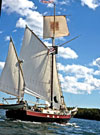 We hope everyone has a great time at today’s 7th Annual Boothbay Boat Builders Festival. All should keep a a weather eye out as there are rumors of an attack by the Pirates of the Dark Rose, followed by a get-together for the kids with the pirates in the Story & Sing-a-Long tent! We wish all pirates were as entertaining and well behaved.
We hope everyone has a great time at today’s 7th Annual Boothbay Boat Builders Festival. All should keep a a weather eye out as there are rumors of an attack by the Pirates of the Dark Rose, followed by a get-together for the kids with the pirates in the Story & Sing-a-Long tent! We wish all pirates were as entertaining and well behaved.
Last February we posted about a “junkraft” built by Dr. Marcus Eriksen and his team of 15,000 plastic bottles, 30 sailboat masts, an airplane fuselage which they sailed 2,600 miles from Los Angeles to Hawaii to make a point about the amount of plastic polluting our oceans and contaminating our food supply. On their voyage they sailed along the edge of the Great Pacific Vortex also known as the Great Pacific Garbage Patch or simply the Plastic Vortex.
A new expedition has recently set sail to research the Plastic Vortex and the impact that it has on the oceans and on our food supply.
Continue reading
 A windfall, a sudden and unexpected occurrence of good fortune, literally refers to fruit or timber knocked down by the wind. Here is an intriguing story of a literal windfall from the Maritime Texas blog.
A windfall, a sudden and unexpected occurrence of good fortune, literally refers to fruit or timber knocked down by the wind. Here is an intriguing story of a literal windfall from the Maritime Texas blog.
Continue reading
A beautifully shot and edited short video. Jon Kane’s comments:
I did this film for my friend Buck McAllister who’s family owns McAllister Towing tug boat company. I shot the film with one camera, in real time, during the towing of the Intrepid Warship back to it’s dock on the West Side of Manhattan after it’s refurbishment. I shot with a Panasonic HVX 200 camera with a polarizer filter and I cut and colored in Final Cut Pro using all the basic tools that come with Final Cut. Nothing fancy.
A short video of sailing on the schooner A.J. Meerwald in New York harbor. The A. J. Meerwald is a Delaware Bay oyster schooner launched in 1928.
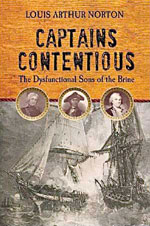 Louis Arthur Norton’s book Captains Contentious – The Dysfunctional Sons of the Brine is an entertaining reminder that history is finally about individuals, dedicated to the causes in which they believe, as well as serving their own needs and obsessions.
Louis Arthur Norton’s book Captains Contentious – The Dysfunctional Sons of the Brine is an entertaining reminder that history is finally about individuals, dedicated to the causes in which they believe, as well as serving their own needs and obsessions.
Norton looks at five ship’s captains who fought for the infant American Navy in the Revolutionary War. When not fighting the British, these captains also fought with each other, with their crews, their peers and with politicians ashore. Their personal quirks and flaws, in turn, hindered their careers and helped shape their victories. Norton examines the exploits of John Manley, Silas Talbot, Dudley Saltonstall, Joshua Barney and John Paul Jones. Each is a fascinating study in the character of these courageous if often flawed naval commanders.
Continue reading
 In his Aubrey/Maturin series, Patrick O’Brian wrote of HMS Surprise, a small British frigate, originally captured from the French. Over several books, the Surprise became almost as beloved a character, in her own way, as Jack Aubrey and Doctor Maturin themselves.
In his Aubrey/Maturin series, Patrick O’Brian wrote of HMS Surprise, a small British frigate, originally captured from the French. Over several books, the Surprise became almost as beloved a character, in her own way, as Jack Aubrey and Doctor Maturin themselves.
Independent of her qualities in fiction, HMS Surprise was indeed a real ship upon which O’Brian based the ship in his novels. Now, Brian Lavery, the noted naval historian and author of more than twenty books on the Royal Navy, and Geoff Hunt, the president Royal Society of Marine Artists and the painter of many of the covers in the Aubrey Maturin series, have written The Frigate Surprise: The Complete Story of the Ship Made Famous in the Novels of Patrick O’Brian.
Continue reading
I am not even quite sure what a “Ferrython” is, but this seemed like an appropriate image for a Friday afternoon. From the Australian National Maritime Museum’s Flickr photostream as spotted on the Sea Fever blog.
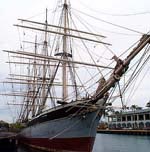 Falls of Clyde is the only surviving iron-hulled four-masted full rigged ship and the only surviving sail-driven oil tanker in the world. She was launched in 1878 in Port Glasgow, Scotland, for the Fall Line . The ship was towed to Hawaii 1968 and opened as a museum in 1971. In 2008, the Bishop Museum, which had control of the ship, was preparing to tow her out to sea and scuttle her.
Falls of Clyde is the only surviving iron-hulled four-masted full rigged ship and the only surviving sail-driven oil tanker in the world. She was launched in 1878 in Port Glasgow, Scotland, for the Fall Line . The ship was towed to Hawaii 1968 and opened as a museum in 1971. In 2008, the Bishop Museum, which had control of the ship, was preparing to tow her out to sea and scuttle her.
In an attempt to save her, the Friends of Falls of Clyde, a tax-exempt group was formed and purchased the ship in September 2008. They are currently working to raise funds to tow the ship to drydock at Kalaeloa by December 29th.
To learn more: Friends of Falls of Clyde works to preserve a historic ship
Friends of Falls of Clyde website
To donate to help save Falls of Clyde: Make a Donation
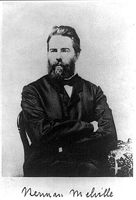 In a comment on a prior post, Fiddler’s Green, Redwing mentioned White Jacket, or The World in a Man-of-War, by Herman Melville. I had never read the novel. I am now doing so and enjoying it very much. (It can be downloaded for free from Project Gutenberg.)
In a comment on a prior post, Fiddler’s Green, Redwing mentioned White Jacket, or The World in a Man-of-War, by Herman Melville. I had never read the novel. I am now doing so and enjoying it very much. (It can be downloaded for free from Project Gutenberg.)
White Jacket and Redburn were apparently each written in two months when Melville was strapped for cash. He was said to have never liked either book, thinking of them as “cakes and ale potboilers”. Melville would say of them that they were “two jobs which I have done for money—being forced to it as other men are to sawing wood”. Ironically, they were both among his most popular books and sold better during his lifetime than any of his later books, including Moby Dick.
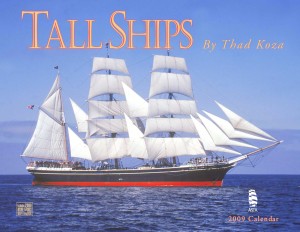 This afternoon, at the 21st Annual Indie and Small Press Book Fair, I had the pleasure of meeting Thad Koza, a wonderful photographer of tall ships. I bought a copy of his Tall Ships 2009 Calendar and plan on buying his book, Tall Ships: the fleet for the 21st century, for myself for Christmas.
This afternoon, at the 21st Annual Indie and Small Press Book Fair, I had the pleasure of meeting Thad Koza, a wonderful photographer of tall ships. I bought a copy of his Tall Ships 2009 Calendar and plan on buying his book, Tall Ships: the fleet for the 21st century, for myself for Christmas.
In addition to his glorious photography his website, Tall Ships International, has an alphabetical listing of tall ships, photographs in his daily log, as well as links to various tall ship sailing sites. Definitely worth checking out.
 Stan Rogers, the late Canadian folk sing/songwriter, sang a song about an ill fated privateering voyage during the American revolution called “Barrett’s Privateer’s“. He was often asked where he learned the song. Most assumed that it was a traditional folk song. Many of the references and details are accurate and appropriate to the period. Nevertheless, Rogers wrote the song around 1976. (Dan Conlin posted an interesting discussion separating the truth from the fiction in Barrett’s Privateers.)
Stan Rogers, the late Canadian folk sing/songwriter, sang a song about an ill fated privateering voyage during the American revolution called “Barrett’s Privateer’s“. He was often asked where he learned the song. Most assumed that it was a traditional folk song. Many of the references and details are accurate and appropriate to the period. Nevertheless, Rogers wrote the song around 1976. (Dan Conlin posted an interesting discussion separating the truth from the fiction in Barrett’s Privateers.)
I recently learned that “Fiddler’s Green” another “traditional sea song” that I am very fond of may not be quite as old or traditional as I might have thought. The song apparently was written and copyrighted in the 1960s by John Connolly, a songwriter from Lincolnshire, England. There is as I’ve learned, a lot more to it than that. Continue reading
From Dione Chen writing in the Museum of Underwater Archeology site:
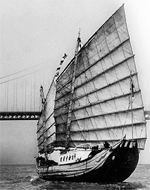 “The Free China is a historic century-old Chinese sailing vessel on the verge of extinction. An authentic Fujian junk used during the first half of the 20th century to transport fish and contraband, the Free China has a rich and colorful past. The junk is possibly the oldest Chinese wooden sailing vessel of operable condition in existence—and the last of its kind.
“The Free China is a historic century-old Chinese sailing vessel on the verge of extinction. An authentic Fujian junk used during the first half of the 20th century to transport fish and contraband, the Free China has a rich and colorful past. The junk is possibly the oldest Chinese wooden sailing vessel of operable condition in existence—and the last of its kind.
The Free China junk made international headlines in 1955 when an inexperienced crew of five Chinese fishermen and one American diplomat beat the odds to make a transpacific voyage from Taiwan to San Francisco. The voyage was an inspiring story of chutzpah, determination, adventure and spirit that was a source of great pride by Chinese on both sides of the Pacific, and significant interest by mariners and the general public in America.
 Tattoos have become very popular of late. Tattoo Facts & Statistics notes that “thirty-six percent of those ages 18 to 25, and 40 percent of those ages 26 to 40, have at least one tattoo, according to a fall 2006 survey by the Pew Research Center.” As popular as tattoos are with twenty and thirty somethings, sailors have been marking their bodies for most of history.
Tattoos have become very popular of late. Tattoo Facts & Statistics notes that “thirty-six percent of those ages 18 to 25, and 40 percent of those ages 26 to 40, have at least one tattoo, according to a fall 2006 survey by the Pew Research Center.” As popular as tattoos are with twenty and thirty somethings, sailors have been marking their bodies for most of history.
 Many years ago a retired ship’s captain told me that his youth deckhands often had “HOLD FAST” tattooed across the knuckles of their hands so they wouldn’t fall when they went aloft. They also often had a pig tattooed on one foot and chicken the other which was supposed to protect you from drowning. He told me that he never figured out which foot was supposed to be tattooed with the chicken and which with the pig. He would say, with a twinkle in his eye, that he never got the tattoos because he was afraid of getting them on the wrong feet.
Many years ago a retired ship’s captain told me that his youth deckhands often had “HOLD FAST” tattooed across the knuckles of their hands so they wouldn’t fall when they went aloft. They also often had a pig tattooed on one foot and chicken the other which was supposed to protect you from drowning. He told me that he never figured out which foot was supposed to be tattooed with the chicken and which with the pig. He would say, with a twinkle in his eye, that he never got the tattoos because he was afraid of getting them on the wrong feet.
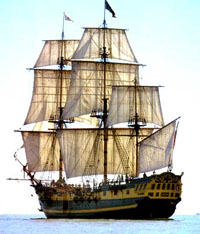 There seems to be a significant number of tall ships for sale these days. Not sure whether that is good or bad news. One especially notable example is the Grand Turk, now offered for sale for £2,800,000. Thanks to Alaric for the heads up.
There seems to be a significant number of tall ships for sale these days. Not sure whether that is good or bad news. One especially notable example is the Grand Turk, now offered for sale for £2,800,000. Thanks to Alaric for the heads up.
“The Grand Turk is a fully-rigged ship – complete with twelve smooth-bored cannon – built in Marmaris, Turkey based on the 18th Century, British, Sixth Rate Frigate, HMS Phoenix, built in 1741. Naval Architect Ron Holland took the historical lines and created working drawings. The UK Maritime and Coastguard Agency (MCA) were involved at all stages of the build Continue reading
For those wishing to learn just a bit about sailor’s knots, Animated Boating Knots by Grog is a lot of fun. Here is a rolling hitch, a marvelously useful knot that I invariably forget how to tie whenever a need one. If you need to climb a halyard, tie a warping line to an anchor rode, or take the load off a sheet fouled on a winch, there is nothing like it. And even if you don’t need to do any of these things it is still a very nice knot to know. After all, what’s knot to like? Sorry.
Continue reading
 Having sailed last week on the Hudson River sloop, Clearwater, a voyage by another Hudson River sloop came to mind. In 1785 the Hudson River sloop Experiment was only the second ship from the young American republic to sail to China.
Having sailed last week on the Hudson River sloop, Clearwater, a voyage by another Hudson River sloop came to mind. In 1785 the Hudson River sloop Experiment was only the second ship from the young American republic to sail to China.
Hudson River sloops were developed by the Dutch for the specific conditions in vast tidal estuary that is the Hudson River below Trenton. They are beamy with low freeboard and shallow draft. Their rig is simple – a huge mainsail to get he most of Continue reading
Hudson River Sloop Clearwater from Rick Spilman on Vimeo.
The Clearwater is a Hudson River sloop modeled after the distinctive trading sloops that sailed up and down the Hudson in the 18th and 19th centuries. The Clearwater was conceived by the folk singer, Pete Seeger, as a way to bring people down to the then very polluted Hudson River. For close to forty years the Clearwater has been a movable classroom, laboratory and stage as she has sailed up and down the vast tidal estuary that is the Hudson River south of Albany. Continue reading
An update on the MV Faina – still being held hostage by Somali pirates.
Somali pirates hold whip hand in standoff
And a comment by my 12 year old son, Ted. He suggested that he would like to learn some Somali so that next year when “Talk Like a Pirate Day” rolls around, he will really be able to talk like a pirate.


